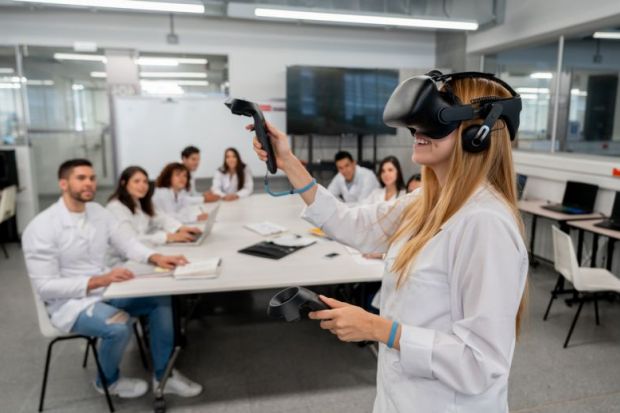
How is Immersive Technology Used in Higher Education?
In the 21st century, adopting innovations in the technological domain is the heartbeat of the learning process.
From the invention of virtual reality to mixed reality, the traditional learning approach has undergone a tremendous transformation that has affected the learning ability of the students.
Immersive technologies, i.e., virtual reality (VR), augmented reality (AR), and mixed reality (MR) have formed a vanguard of a new educational era that points to dynamic and experiential learning.
Wait! So, how exactly these immersive technologies are being harnessed in higher education, and what benefits do they offer to students and educators alike? Let’s find out the answer below-
Virtual Laboratories
With the introduction of immersive learning in higher education institutions, subjects like Chemistry, physics, and biology have not only been restricted to the respective labs.
Today, the students can go into VR headsets and AR goggles and handle the chemicals without worrying about the safety in the virtual lab that replicates the traditional labs.
Thanks to the invention of virtual laboratories. Here are the benefits of Virtual laboratories for students and teachers alike-
Safety Meets Exploration- Mishandling the experiments or accidental chemical spills? Well, this is the issue of the past.
Within the virtual lab setup, students can delve fearlessly into experiments without the worry of real-world consequences.
Thus, the Virtual labs ensure that a secure learning environment is created for the students where they are encouraged to push the boundaries of their scientific curiosity.
Repetition refined- Within the virtual lab, there is no limit for the students to use the platform. They can reset and replay the digital experiments as many times as they want at the click of a button.
Isn’t it impressive? With its ability to repeat experiments virtually, students can master their techniques, test alternative hypotheses, and truly grasp the cause-and-effect relationships inherent in scientific principles.
Fostering a Deeper Understanding- With the virtual labs, students are immersed in a world that goes beyond the textbook learning that is filled with theoretical concepts only.
Students are not just passive observers. They are active participants who are allowed to manipulate variables, observe outcomes, and make connections in such a way that transcends traditional classroom experiences.
Virtual Field Trips
If you are still learning through textbooks, then, you are living in the past.
Why are you still stuck in the 2D world of books and pages if you can immerse yourself in those concepts? Today, with the help of immersive technology for virtual learning, students can depict historical landmarks or geological formations right in front of their eyes.
Asking how?
By taking virtual field trips. All you have to do is wear a VR headset and with a few clicks you can explore historical sites, visit the engineering construction site, dive inside an ocean, and even visit a virtual operation room.
What is more to demand here now? The introduction of virtual field trips not only makes learning more exciting but also ensures that students have a richer, more tangible understanding of the subjects.
Immersive Simulations
When it comes to academia, mastering complex concepts can be a significant challenge for individuals learning with traditional teaching methods.
Fundamentally, these learning methods can sometimes fall short of providing students with enough visceral understanding of abstract concepts.
The possible solution to this concern is the integration of immersive learning simulations with the traditional methods of teaching.
Here are the possible benefits of virtual reality in education it offers through immersive simulations-
Beyond Visualization- To be precise, what sets immersive simulations apart is their ability to transcend traditional visualization.
Immersion offered by modern technologies is not just about seeing a concept on a screen, but it is about living it.
With these technologies in education, students can actively participate in suturing in the operation room, gaining hands-on experience.
The Bridge to Practical Application- In one place where the traditional learning approach restricts the students to the theoretical concepts only, the immersive technologies allow them to actively participate in the learning process.
The simulations provide a space for experimentation, allowing learners to test theories, learn from mistakes, and refine their approaches.
This iterative process mirrors the real-world challenges professionals face, preparing students for the dynamic and ever-evolving landscapes of their chosen fields.
Business in the Boardroom: These technologies allow business students to step into the shoes of the decision-makers where they are met with the complexities of the corporate world.
They can make strategies, analyze market trends, and make strategic decisions. But, the twist is that they can do all this in a risk-free virtual boardroom.
This approach helps students in developing a keen understanding of the consequences of their decisions.
Conclusion
To sum up, the increasing use of immersive technologies in the higher education classroom has expanded the boundaries of the traditional classroom.
Well, this change is the need of the hour it is going to create an interactive, engaging, and effective educational environment in the near future.
But this is not that far. So, it is the correct time to fasten the seatbelts and get on the adventurous voyage toward the classroom for the future that knows no boundaries. Ready?



